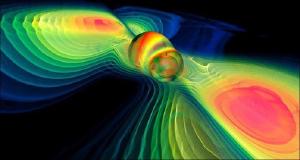Blog
Recoil Effect
29 October 2014
 Werner Benger, cc-by-sa 4.0
Werner Benger, cc-by-sa 4.0Most galaxies have a supermassive black hole in their centers, but some don’t. The Triangulum galaxy (also known as M33) doesn’t have one, despite being a pretty standard looking spiral galaxy. The general thought is that such galaxies did have a supermassive black hole at one time, but it was ejected by some mechanism. One mechanism is through collisions with other galaxies, but there are other possible mechanisms as well. Now a new paper in the Astrophysical Journal has found some hints of these.1
The authors looked at archive data from the Hubble space telescope on 14 nearby galaxies. They found that in 10 of these galaxies the supermassive black hole was shifted by several light years from the optical center of the galaxy. In other words, for these galaxies the black hole was slightly off center. Since these black holes can be millions or even billions of solar masses, something pretty big must have knocked them out of the center.
It’s generally been assumed that such shifts would be due to a black hole merger, where one black hole can collide with another and cause it to shift position. But given that such a large majority of these galaxies had shifted black holes, that isn’t likely to be the case for all of them. Black hole mergers just aren’t common enough to cause all these shifted black holes.
So if mergers can’t account for all of these shifted black holes, what can? We aren’t entirely sure, but the authors did find a possible mechanism. When they looked at the direction of shift for these 1o black holes, they found they tended to be along the same direction as the jets of these black holes. This means it’s possible that asymmetrical jet emissions could cause the black holes to recoil, thus shifting them away from galactic center. We’ve seen similar effects with neutron stars, where the asymmetry of the supernova producing the neutron star causes it to recoil at high speed.
The statistical alignment observed could be caused by other mechanisms as well, so there isn’t enough evidence to confirm the jet hypothesis. What is clear is that the dynamics of supermassive black holes are more complex than once thought, and some of these effects can cause million solar-mass black holes to recoil in measurable ways, which is pretty impressive when you think about it.
Lena, Davide, et al. “Recoiling supermassive black holes: A search in the nearby Universe.” The Astrophysical Journal 795.2 (2014): 146. ↩︎